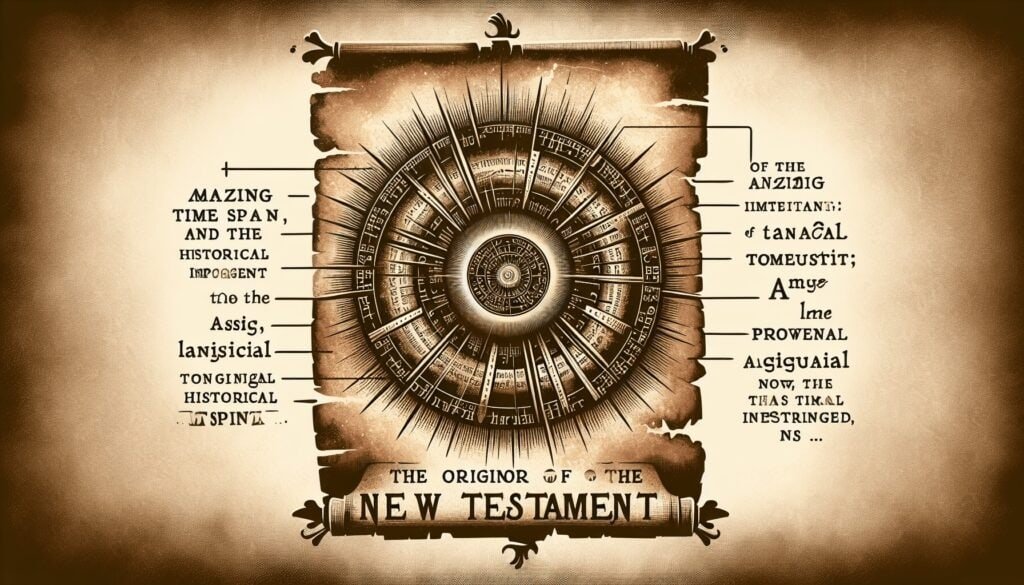Did you ever wonder what language the original New Testament Bible was written in? Well, the answer may surprise you. The New Testament, that sacred collection of texts that encapsulates the life and teachings of Jesus Christ, was actually written in Greek. Yes, Greek! This captivating fact shines a spotlight on the rich linguistic history of Christianity and the interconnectedness of cultures in the ancient world. With her extensive knowledge and expertise, Anita Love, a renowned scholar who has dedicated her life to the study of theology and religious texts, sheds light on this fascinating topic. So, let’s join Anita on this journey of discovery as we delve into the original language of the New Testament Bible.

” style=’text-decoration: none; box-shadow: none;’>
Historical Background of the New Testament
Relevance of the historical context in understanding the New Testament
The historical context plays a crucial role in understanding the New Testament. By examining the political, social, and cultural climate in which the texts were written, we gain a deeper appreciation for the messages conveyed. For example, understanding the influence of Hellenistic culture on the Jewish people during the time of the New Testament helps us comprehend the blending of Greek and Hebrew ideas in the writings.
Historical periods associated with the New Testament composition
The composition of the New Testament spans several historical periods. It begins with the life of Jesus Christ and the events surrounding his ministry in the 1st century AD. This is followed by the establishment of early Christian communities and the writings of the apostles. Notable historical periods associated with the New Testament include the Roman occupation of Palestine, the spread of Christianity throughout the Mediterranean world, and the emergence of diverse theological perspectives within the early Christian movement.
Ancient Biblical Languages
Significance of the Hebrew, Aramaic, and Greek languages
The ancient biblical languages of Hebrew, Aramaic, and Greek hold great significance in our understanding of the Old and New Testaments. Hebrew is the language in which the majority of the Old Testament was written, while Aramaic appears in specific portions. Greek, on the other hand, is the primary language used in the New Testament. Familiarity with these languages allows us to engage directly with the original texts and gain insights that may be lost in translation.
Different biblical languages used across the Old and New Testaments
The Old Testament primarily consists of Hebrew text, with sections of Aramaic found in books such as Daniel and Ezra. Hebrew was the language of the Jewish people and formed the foundation of their religious and cultural identity. In contrast, the New Testament was written in Greek, which was the lingua franca of the eastern Mediterranean at the time. This shift in language reflects the changing demographics and cultural dynamics of the region.
Primary Language of the New Testament
Greek as the main language of the New Testament
Greek is the main language of the New Testament, with all of its books being written in this language. This choice of language was influenced by various factors, including the widespread use of Greek in the Eastern Mediterranean, the cultural influence of Hellenism, and the need for a common language to communicate the message of Christianity to diverse communities.
Reason behind Greek’s predominance in the New Testament era
Greek’s predominance in the New Testament era can be attributed to several factors. Firstly, Alexander the Great’s conquests spread Greek language and culture throughout much of the known world at the time. This Hellenistic influence made Greek the language of education, commerce, and administration. Additionally, the Septuagint, a Greek translation of the Hebrew Bible, was widely used by Jewish communities, further establishing Greek as a significant language. Choosing Greek for the New Testament allowed for wider dissemination of the Christian message among both Jewish and Gentile audiences.

” style=’text-decoration: none; box-shadow: none;’>
Greek Dialects Used in the New Testament
Understanding Koine Greek
Koine Greek is the form of Greek used in the New Testament. It originated as a simplified version of Classical Greek and was the common language of daily life during the Hellenistic period. Koine Greek was characterized by its simpler grammar and vocabulary, making it accessible to a broader range of people. Understanding the features of Koine Greek helps in properly interpreting the New Testament texts.
Significance and characteristics of Koine Greek in the New Testament
The use of Koine Greek in the New Testament is significant for its accessibility and inclusivity. By employing a language that was widely spoken and understood by diverse communities, the early Christian writers were able to effectively communicate their message and reach a larger audience. Koine Greek’s characteristics, such as its flexibility and adaptability, allowed for the expression of complex theological concepts in a language that was easily understood by the common people.
Translation of the New Testament over time
Early translations from Greek into Latin, Syriac, and Coptic
Soon after the composition of the New Testament, translations began to emerge to make its message accessible to communities outside the Greek-speaking world. Latin, Syriac, and Coptic were among the earliest translations, enabling Christians in different regions to engage with the scriptures in their native tongues. These translations played a crucial role in the spread of Christianity and the development of distinct theological traditions.
Impact of translation on interpretation and understanding of the New Testament
Translation has a significant impact on the interpretation and understanding of the New Testament. As the text is rendered into different languages, nuances and cultural contexts may be lost or altered. Translators must make choices regarding word choice, sentence structure, and idiomatic expressions, which can influence how the message is received by readers. It is important for scholars and theologians to study multiple translations and consult the original Greek text to ensure a comprehensive understanding of the New Testament’s teachings.
Role of Language in Conveying the Message of the New Testament
How language styles and literary devices influence understanding
Language styles and literary devices used in the New Testament play a crucial role in conveying its message. The writers employed various techniques such as metaphors, parables, and rhetorical devices to communicate complex theological ideas in relatable ways. Understanding these language styles and literary devices helps us interpret the texts accurately and appreciate the artistry of the New Testament writings.
Examples of specific Greek words or phrases with significant meanings in the New Testament
Numerous Greek words and phrases in the New Testament carry significant meanings that enhance our understanding of its message. For example, the Greek word “agape” is often translated as “love” and signifies a selfless, unconditional love. Another example is the use of the word “logos,” which conveys the concept of God’s divine wisdom and creative power. These specific Greek words and phrases add depth and nuance to the theological themes presented in the New Testament.
Messianic Prophecies and their Greek Connotations
Greek terminology in New Testament prophecies
Messianic prophecies in the New Testament often incorporate Greek terminology to convey their significance. These Greek terms carry cultural and religious connotations that would have been understood by the audience of that time. For example, the use of the word “Christos” (Christ) emphasizes Jesus’ role as the anointed Messiah, drawing upon Greek ideas of divine kingship. Understanding these Greek connotations enriches our interpretation of the prophetic messages in the New Testament.
How Jesus’ portrayal in the Gospels reflects Greek cultural and linguistic context
The portrayal of Jesus in the Gospels reflects the cultural and linguistic context influenced by Greek civilization. The use of Greek language and concepts allows for a broader understanding of Jesus’ teachings and identity. For example, the concept of Jesus as the “Logos” in the Gospel of John resonates with the Greek philosophical idea of a divine, rational principle. This blending of Greek cultural and linguistic influences enhances our appreciation of Jesus’ significance within his historical context.
Comparing Language Use in the Old and New Testaments
Differences and similarities in language and style between the Old and New Testaments
The Old and New Testaments exhibit both differences and similarities in terms of language and style. The Old Testament is primarily written in Hebrew, characterized by its poetic and prophetic language. In contrast, the New Testament uses Greek, a more straightforward and accessible language influenced by Koine Greek. While there are variations in language and style, both Testaments share common themes, such as the redemption of humanity and the pursuit of righteousness.
Impact of different languages on interpreting Law, Covenant, Redemption themes
The use of different languages in the Old and New Testaments contributes to varying interpretations of concepts such as Law, Covenant, and Redemption. In the Hebrew context, the Law carries weight as a divine mandate central to the covenant relationship between God and His people. In the New Testament, the emphasis shifts towards a new covenant based on grace and the redemptive work of Jesus Christ. Understanding the linguistic nuances in these concepts allows for a comprehensive interpretation of their theological implications.
Modern Translations of the New Testament
Challenges in translating New Testament Greek to modern languages
Translating New Testament Greek to modern languages presents several challenges. Greek is a complex and nuanced language, and capturing its full meaning in translation requires careful consideration of cultural and contextual factors. Translators must navigate the subtleties of Greek grammar, syntax, and vocabulary to ensure accuracy and faithfulness to the original text. They also face the challenge of finding equivalent expressions and idioms in the target language that effectively convey the intended message.
Preserving authenticity and accuracy in modern translations
Preserving authenticity and accuracy in modern translations of the New Testament is of utmost importance. To maintain the integrity of the original text, translators employ various strategies, including close examination of ancient manuscripts, consultation with biblical scholars, and consideration of linguistic and cultural contexts. Additionally, collaborative efforts within translation teams and adherence to established translation principles ensure that modern translations faithfully reflect the teachings and message of the New Testament.
Effect of Greek Language on Christian Theology
Influence of Greek philosophical concepts on Christian thought
The Greek language’s influence on Christian theology is seen through the incorporation of Greek philosophical concepts. Early Christian thinkers drew upon Greek ideas to articulate and defend Christian beliefs. For example, the concept of the Logos heavily influenced the development of the doctrine of the Trinity. Greek philosophical terminology enabled Christian theologians to engage in intellectual discourse and express theological concepts in a language accessible to the wider Greco-Roman world.
How the use of Greek in the New Testament shaped Christian practices and beliefs
The use of Greek in the New Testament played a significant role in shaping Christian practices and beliefs. By employing the Greek language, the early Christian writers facilitated the spread of the Gospel message, fostering the growth of Christian communities and the development of shared theological understandings. Greek’s influence on Christian thought influenced the formulation of creeds, the establishment of theological schools, and the formation of doctrines that shaped the character of Christianity for centuries to come.
In conclusion, a comprehensive understanding of the New Testament requires an exploration of its historical background, ancient biblical languages, the primary use of Greek, translation challenges, and the impact of language on conveying the message of the New Testament. By delving into these topics, we gain valuable insights into the cultural, linguistic, and theological dimensions of the New Testament, enhancing our interpretation and appreciation of its teachings.



